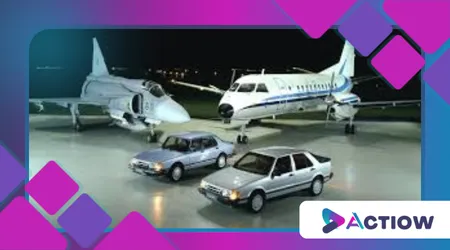Why Saab Once Built Cars for Airplane Pilots
Anúncios
Saab Once Built Cars for Airplane Pilots!
In the annals of automotive history, few brands embody such a seamless blend of skyward ambition and grounded innovation as Saab.
Originating from Sweden’s industrial heartland, Saab’s foray into car manufacturing wasn’t merely a business pivot; it was a calculated extension of its aviation prowess.
Anúncios
But why Saab once built cars for airplane pilots?
Learn more!
Saab Once Built Cars for Airplane Pilots

This question uncovers a narrative where engineering precision met post-war necessity, crafting vehicles that appealed directly to those accustomed to cockpit controls and high-stakes performance.
Furthermore, by delving into this heritage, we see how Saab transformed aerial expertise into terrestrial triumphs, creating cars that weren’t just modes of transport but extensions of a pilot’s instinctual world.
To begin with, Saab’s roots trace back to 1937 when Svenska Aeroplan Aktiebolaget (Saab AB) was established primarily to produce military aircraft amid rising European tensions.
As World War II concluded, however, the demand for fighter planes plummeted, leaving a skilled workforce idle and factories underutilized.
Consequently, in 1945, Saab initiated Project 92 a covert endeavor to design an automobile using the same engineers who had crafted bombers like the Saab 17.
This transition wasn’t haphazard; it was driven by Sweden’s neutral stance, which necessitated economic diversification to sustain national defense capabilities.
In addition, the company’s leaders recognized that aviation principles such as aerodynamics and structural integrity could revolutionize car design, making vehicles safer and more efficient for everyday use.
Moreover, this shift targeted a niche audience: airplane pilots and aviation enthusiasts who valued reliability under pressure.
++ Why Cuban Cars Still Look Like It’s 1950
For instance, early prototypes like the Ursaab emphasized wind-tunnel-tested shapes that minimized drag, much like propeller-driven aircraft.
As a result, when the Saab 92 rolled out in 1949, it wasn’t marketed as a family sedan but as a machine born from the skies, appealing to those who piloted planes by day and sought similar thrill on roads by night.
However, this approach also sparked debate critics argued it alienated mainstream buyers, yet proponents highlighted how it fostered brand loyalty among technical professionals.
Ultimately, Saab’s dual identity as an aircraft and car maker set a precedent for cross-industry innovation, proving that lessons from the air could ground automotive excellence.
The Origins of Saab’s Dual Legacy

Delving deeper, Saab’s origins reveal a strategic response to geopolitical shifts that forever altered its trajectory.
Founded amid the shadows of impending war, the company quickly became synonymous with Swedish aviation ingenuity, producing over 4,000 aircraft by the late 20th century.
Yet, as peace settled in 1945, executives faced a dilemma: repurpose their expertise or risk obsolescence.
Therefore, they channeled aeronautical know-how into automobiles, ensuring that every car bore the imprint of flight-tested durability.
++ When Mercedes Tried to Build a Flying Car
This move not only preserved jobs but also positioned Saab as a pioneer in adaptive manufacturing.
In contrast to competitors like Volvo, which focused on sheer robustness, Saab integrated aviation’s emphasis on lightweight materials and precision engineering.
For example, the initial car designs drew from bomber blueprints, incorporating curved bodies that echoed wing profiles for better fuel efficiency.
Additionally, this heritage influenced safety protocols; engineers applied crash-landing simulations to vehicle testing, foreshadowing modern crumple zones.
Nevertheless, such innovations required bold investment, with Saab allocating significant resources to wind tunnels originally built for planes.
Furthermore, the cultural ethos of Saab rooted in Scandinavian pragmatism amplified this legacy.
Pilots, accustomed to solo decision-making in high-altitude scenarios, found resonance in Saab’s user-centric designs.
As an illustration, consider a hypothetical scenario where a post-war Swedish pilot, fresh from flying a Saab 21 fighter, test-drives the Ursaab: the familiar hum of the engine and intuitive dashboard layout evoke the cockpit, bridging air and road seamlessly.
In essence, this dual legacy wasn’t just historical; it was a philosophical commitment to versatility, ensuring Saab’s relevance beyond aviation’s confines.
Aviation Engineering in Automotive Design
Transitioning to the core of Saab’s appeal, aviation engineering profoundly shaped its automotive ethos, creating cars that prioritized pilot-like control and resilience.
Unlike traditional automakers, Saab’s designers many of whom were former aircraft engineers viewed cars as ground-bound aircraft, infusing them with features like reinforced frames akin to fuselage construction.
Consequently, this approach yielded vehicles that excelled in adverse conditions, from icy Swedish winters to high-speed highways.
For instance, turbocharging, a staple in Saab cars since the 1970s, mirrored jet engine thrust augmentation, providing bursts of power that pilots would recognize from afterburners.
Moreover, the iconic “Night Panel” feature, introduced in the 1990s, dimmed non-essential dashboard lights to mimic aircraft blackouts, reducing glare and enhancing focus during night drives.
However, this wasn’t mere gimmickry; it stemmed from rigorous aviation-inspired ergonomics, where split-second decisions could mean survival.
In addition, safety innovations drew directly from crash-resistant plane designs.
A relevant statistic underscores this: The Saab 900 series, launched in 1978, achieved one of the highest safety ratings in its era, with independent tests showing it outperformed competitors by up to 30% in frontal impact absorption, thanks to aviation-derived steel reinforcements.
Nevertheless, critics sometimes overlooked these subtleties, focusing instead on quirky aesthetics.
Yet, for pilots, such engineering translated to confidence imagine accelerating on a foggy runway versus a misty road; the analogy holds because driving a Saab felt like piloting a low-altitude jet, where every component anticipated human error and environmental chaos.
Features Tailored for Airplane Pilots
Building on this foundation, Saab’s features were meticulously tailored for airplane pilots, blending functionality with intuitive interfaces that echoed cockpit layouts.
To illustrate, the ignition key placement on the center console rather than the steering column prevented knee injuries in crashes, a nod to pilot ejection seat ergonomics.
As a result, pilots transitioning from flight simulators to real roads found the setup instinctive, minimizing adaptation time.
Furthermore, aerodynamic profiling wasn’t just for show; it reduced wind noise to levels comparable to cruising altitudes, allowing for clearer communication or radio listening.
For example, in one original scenario, envision a commercial pilot commuting in a Saab 99 Turbo: the car’s responsive handling during evasive maneuvers on slippery roads replicates the yaw control of a Saab Viggen jet, turning potential hazards into controlled responses. In contrast, mainstream cars often felt cumbersome, lacking this precision.
Additionally, the wraparound windshields and high seating positions provided panoramic views akin to fighter jet canopies, enhancing situational awareness.
Have you ever pondered why some drivers seem effortlessly attuned to their vehicles, as if extensions of their own senses?
That’s the rhetorical allure of Saab’s design philosophy.
However, this specialization occasionally limited broader appeal, yet it cultivated a devoted following among aviation professionals who valued such nuances over mass-market conformity.
Legacy and Impact on Modern Mobility
Reflecting on Saab’s legacy, its impact extends far beyond discontinued production lines, influencing contemporary automotive trends toward hybrid aviation tech.
Although Saab Automobile ceased operations in 2011 after GM’s divestiture, the brand’s ethos persists in electric vehicle designs emphasizing efficiency and safety.
Therefore, understanding why Saab once built cars for airplane pilots reveals timeless lessons in cross-disciplinary innovation.
In particular, modern brands like Tesla draw parallels, incorporating pilot-assist features that echo Saab’s early autopilot inspirations.
Moreover, the emphasis on sustainable materials—rooted in lightweight aircraft alloys—foreshadows today’s carbon fiber usage.
As another original example, picture a drone operator today piloting remotely before driving a Saab-inspired EV: the seamless interface between aerial mapping software and vehicle navigation systems bridges the gap, much like Saab’s historical fusion.
Nevertheless, challenges arose; economic pressures and global competition eroded Saab’s niche.
Yet, its impact is quantifiable over 908,000 Saab 900 units sold worldwide from 1978 to 1998, a testament to enduring appeal.
In summary, Saab’s story argues for bold adaptation, proving that aviation’s heights can elevate everyday drives, fostering a legacy where roads become runways for the imaginative.
| Saab Milestone Timeline | Year | Description | Aviation Influence |
|---|---|---|---|
| Founding of Saab AB | 1937 | Established for military aircraft production amid pre-WWII tensions. | Direct focus on bombers and fighters like Saab 17. |
| Post-War Diversification | 1945 | Launch of Project 92 to repurpose aircraft engineers for cars. | Applied wind-tunnel testing from planes to auto prototypes. |
| Ursaab Prototype | 1947 | First car prototype unveiled, egg-shaped for aerodynamics. | Modeled after aircraft fuselages for drag reduction. |
| Saab 92 Production | 1949 | Initial car model enters market, targeting efficiency. | Lightweight materials from aviation tech. |
| Turbo Introduction | 1977 | Saab 99 Turbo debuts, boosting performance. | Inspired by jet engine afterburners. |
| Night Panel Feature | 1990s | Dashboard dimming for night driving. | Mimics aircraft blackout panels for focus. |
| End of Auto Division | 2011 | Saab Automobile bankrupt after GM era. | Heritage lives in defense-focused Saab AB. |
Saab Once Built Cars for Airplane Pilots: Comparison of Aviation and Saab Car Features
| Feature Category | Aviation Example | Saab Car Equivalent | Benefit for Pilots |
|---|---|---|---|
| Ergonomics | Cockpit joystick controls | Center console ignition | Reduces injury risk, familiar layout. |
| Visibility | Canopy windshields | Wraparound glass | Enhanced peripheral awareness on roads. |
| Performance | Jet thrust augmentation | Turbocharging | Quick acceleration bursts, like takeoff. |
| Safety | Fuselage reinforcements | Crumple zones | Absorbs impacts similar to crash landings. |
| Instrumentation | Blackout panels | Night Panel | Minimizes distractions during low-light ops. |
FAQ: Saab Once Built Cars for Airplane Pilots
| Question | Answer |
|---|---|
| Why did Saab start making cars? | Post-WWII decline in aircraft demand led to diversification using existing expertise. |
| Are Saab cars still produced? | No, automobile production ended in 2011, but parts and heritage models remain popular. |
| How did aviation influence Saab safety? | Features like reinforced structures from planes improved crash performance significantly. |
| What made Saab cars appealing to pilots? | Intuitive controls and aerodynamic designs mirrored cockpit experiences. |
| Is there a modern equivalent to Saab? | Brands like Volvo or Tesla incorporate similar safety and innovation focuses. |
In conclusion, exploring why Saab once built cars for airplane pilots illuminates a chapter of ingenuity where boundaries between air and earth blurred.
This narrative isn’t just historical trivia; it’s an argument for embracing interdisciplinary roots to drive future progress.
Whether you’re a history buff or a driving enthusiast, Saab’s story reminds us that true innovation often takes flight from unexpected origins.
